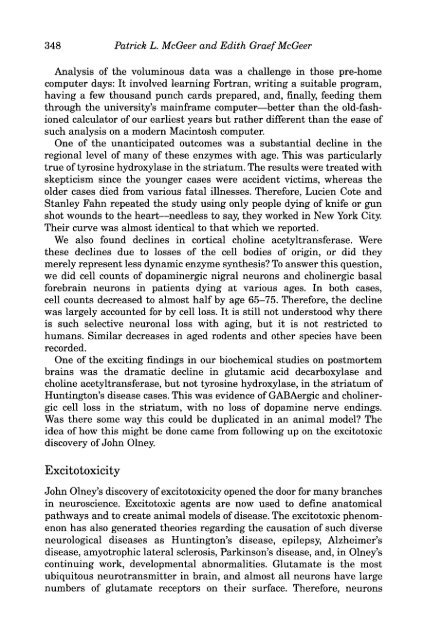Edith Graef McGeer - Society for Neuroscience
Edith Graef McGeer - Society for Neuroscience
Edith Graef McGeer - Society for Neuroscience
You also want an ePaper? Increase the reach of your titles
YUMPU automatically turns print PDFs into web optimized ePapers that Google loves.
348 Patrick L. <strong>McGeer</strong> and <strong>Edith</strong> <strong>Graef</strong><strong>McGeer</strong><br />
Analysis of the voluminous data was a challenge in those pre-home<br />
computer days: It involved learning Fortran, writing a suitable program,<br />
having a few thousand punch cards prepared, and, finally, feeding them<br />
through the university's mainframe computer—better than the old-fashioned<br />
calculator of our earliest years but rather different than the ease of<br />
such analysis on a modern Macintosh computer.<br />
One of the unanticipated outcomes was a substantial decline in the<br />
regional level of many of these enzymes with age. This was particularly<br />
true of tyrosine hydroxylase in the striatum. The results were treated with<br />
skepticism since the younger cases were accident victims, whereas the<br />
older cases died from various fatal illnesses. There<strong>for</strong>e, Lucien Cote and<br />
Stanley Fahn repeated the study using only people dying of knife or gun<br />
shot wounds to the heart—needless to say, they worked in New York City.<br />
Their curve was almost identical to that which we reported.<br />
We also found declines in cortical choline acetyltransferase. Were<br />
these declines due to losses of the cell bodies of origin, or did they<br />
merely represent less dynamic enzyme synthesis? To answer this question,<br />
we did cell counts of dopaminergic nigral neurons and cholinergic basal<br />
<strong>for</strong>ebrain neurons in patients dying at various ages. In both cases,<br />
cell counts decreased to almost half by age 65-75. There<strong>for</strong>e, the decline<br />
was largely accounted <strong>for</strong> by cell loss. It is still not understood why there<br />
is such selective neuronal loss with aging, but it is not restricted to<br />
humans. Similar decreases in aged rodents and other species have been<br />
recorded.<br />
One of the exciting findings in our biochemical studies on postmortem<br />
brains was the dramatic decline in glutamic acid decarboxylase and<br />
choline acetyltransferase, but not tyrosine hydroxylase, in the striatum of<br />
Huntington's disease cases. This was evidence of GABAergic and cholinergic<br />
cell loss in the striatum, with no loss of dopamine nerve endings.<br />
Was there some way this could be duplicated in an animal model? The<br />
idea of how this might be done came from following up on the excitotoxic<br />
discovery of John Olney.<br />
Excitotoxicity<br />
John Olney's discovery of excitotoxicity opened the door <strong>for</strong> many branches<br />
in neuroscience. Excitotoxic agents are now used to define anatomical<br />
pathways and to create animal models of disease. The excitotoxic phenomenon<br />
has also generated theories regarding the causation of such diverse<br />
neurological diseases as Huntington's disease, epilepsy, Alzheimer's<br />
disease, amyotrophic lateral sclerosis, Parkinson's disease, and, in Olney's<br />
continuing work, developmental abnormalities. Glutamate is the most<br />
ubiquitous neurotransmitter in brain, and almost all neurons have large<br />
numbers of glutamate receptors on their surface. There<strong>for</strong>e, neurons











![[Authors]. [Abstract Title]. - Society for Neuroscience](https://img.yumpu.com/8550710/1/190x245/authors-abstract-title-society-for-neuroscience.jpg?quality=85)





